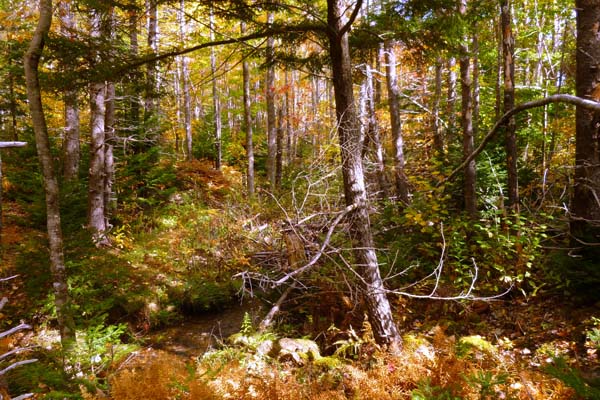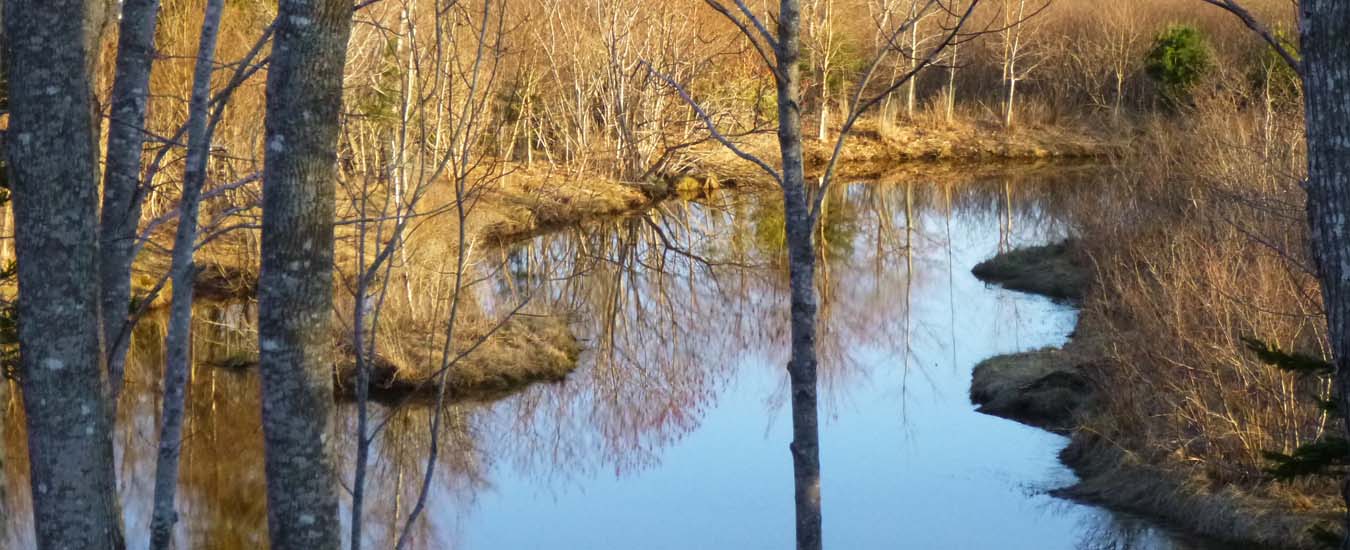Part 4 of a series about working with nature, instead of over-powering it
Forests and freshwater ecosystems are survival necessities for the wild plants and animals that inhabit woodlands. A watershed is a land area surrounded by higher ground. Precipitation along with spring-fed water seep downhill through soils, eventually surfacing as a brook. Depending on the size of the drainage area, brooks can merge into streams, ponds, lakes and rivers before emptying into the ocean.
To function naturally, waterways need a large portion of the watershed to be covered in forest. Land-clearing European settlers who arrived in North America failed to understand or respect how “watersheds” function. Too much forest removal in a watershed results in hit-and-run, destructive rains. Woodland foliage captures the sunlight, soaks up water and the resulting shade moderates air temperatures, creating cooler ground conditions. This also gives moisture time to soak into the ground and be retained longer in the upper soil layers. For more details about freshwater and landscapes, see Saltscapes Vol.1, No.3, “Cry Me a River”.
The small brook on the coastal 56 acre woodland that I purchased in the 1970s begins in a forested hardwood swamp west of our property. Another smaller brook to the south travels through farm fields before joining it. Land clearing had both brooks flushing like toilets after heavy rains. Water tore down the channels, causing excessive streambank erosion and spreading silt throughout the stream. The silt infilled spaces between the stones on the channel bottom, choking the aquatic life that normally lived there. The two brooks had become ditches to the harbour, transporting soil and much of its organic nutrients away in their water. Sediments settle to the harbour bottom when they meet its quiet water.
I began interrupting those flashy torrential rains by placing rocks and logs in the brook channel to slow the flow and create plunge pools. In healthy forests, live tree roots hold streambanks in place until the trees eventually die and fall down. Logs are swept downstream, fetching up across the channel and forcing high water around and over them. Eventually the plunging action they create during strong flows scours out the bottom silt, and gradually re-creates a meander pattern in the channel, with each bend slowing the water down. With time, the flows from a given amount of rain become moderated, and have less erosive power. There’s a lot of science to accomplishing this.

October in the barred owl woods with a hemlock beside the brook.
Water from the two brooks merged on the valley floor. There, generations ago, about 10 acres of white and black ash, yellow birch, red maple and white spruce had been cleared and the land was fenced for pasture. Heavy domestic animals subsequently trampled the original stream channels, causing the water to run willy-nilly over the valley floor after heavy rains. Fish passage was blocked from the harbour to the forest. Exposed to sunlight during the summer and into the fall, that part of the floodplain dried out completely. After the livestock was removed from this pasture, willows and alders began growing in over it. This is nature’s way of beginning to heal the land, and, in time, the tree roots would encourage the creation of new brook channels to carry water downstream. With that comes fish passage.
When I bought this land, I envisioned a pond located on the lower end of the cleared floodplain that could collect the water before it passed through a salt marsh and reached the harbour. In the fall of 2003, a government inspector found no fish habitat there and authorized me to proceed. Permits are required if one is going to alter established freshwater channels. I hired a contractor with an excavator, bulldozer, and several trucks. This story is documented in Saltscapes January/February, 2005 and updated in July/August, 2006.
My wife Alice and I designed a plan and removed the alders and willows from the area where the pond would be dug. A 15,000 square foot pond was excavated during a very dry late summer. Rather than a round or square hole, we had the contractor leave small headlands, coves, and an island. There were shallow areas for aquatic plants, and a three-metre deep water zone for overwintering fish and amphibians. Organic topsoil from the digging was distributed along its east and south sides over excavated deeper soil, creating a berm. Excess clay soil was used to upgrade the woodland road to a spring on the property, then topped with gravel.
By gathering the wandering floodplain water, the pond offers valuable, quiet-water habitats for wildlife. Water flows out of the pond freely, without a dam, through what little remains of the floodplain forest, a marsh and into the harbour. We planted local native aquatic vegetation including white water lilies, pickerelweed and smartweed.
There’s a private bay on the pond out of our home’s view for shy wild visitors. Wooded borders provide shade for the water and are frequented by white-tailed deer, black bears, coyotes, raccoons and bobcats.
Many species of fish now arrive at the pond from the harbour during high water events. These include smelt, gaspereau, mummichogs, sticklebacks, eels, brown trout and speckled trout. These fish attract bald eagles, great blue herons, bitterns, kingfishers, barred owls, otters and mink. Muskrats ply the waters, delivering grassy salads to their bankside dens and youngsters. A variety of ducks use the pond and nest nearby. Cavity nesters like hooded mergansers and wood ducks spy the nest box I put up for them and compete for its use. Beavers passing through check the many trees I planted near the pond, but the base of each tree is protected by four foot high, welded wire mesh with one-inch spacing.
I wondered if the depth of the pond was sufficient for fish to overwinter until one February day when I saw an otter on the ice eating a large trout. I also had to think about the fish. The pond was a bare clay hole underwater, and I watched four or five otters chasing fish into the shallows and trapping them. Natural ponds have trees that fall into them. I gathered a large bundle of tree limbs, wrapped them tightly, weighted them and, using a canoe, sank them in the deepest spot. The trout now have a place to hide.
When I first arrived, black flies were rare. With silt cleansed from the stream bottoms, underwater stones now have spaces between them for aquatic insects and are often speckled with black fly larvae. Swatting the biting adults each spring, I now remind myself that black flies are part of a healthy aquatic food chain.
Ponds and streams attract an amazing number of neighbours, increasing biodiversity, which is much needed in our rapidly diminishing natural world. The forests that surround and shade waterways are essential to their survival. One might say that freshwater and forests go hand-in-hand. If you can lend a hand, so much the better!
In the next issue I’ll discuss the role of vernal pools in forests.
